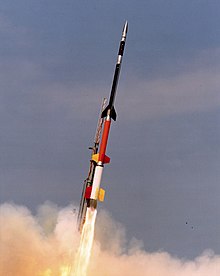Sounding rocket: Difference between revisions
→Operators and Programmes: precise number |
No edit summary |
||
| Line 28: | Line 28: | ||
* [[Rexus and Bexus|REXUS]], German-Swedish rocket programme at [[Esrange]] for [[German Aerospace Center|DLR]] and [[ESA]] student experiment programmes |
* [[Rexus and Bexus|REXUS]], German-Swedish rocket programme at [[Esrange]] for [[German Aerospace Center|DLR]] and [[ESA]] student experiment programmes |
||
* The NASA Sounding Rocket Program |
* The NASA Sounding Rocket Program |
||
* The JAXA operates the sounding rockets S-310/S-520/SS-520 |
* The [[JAXA]] operates the sounding rockets [[S-310]]/[[S-520]]/SS-520 |
||
* [[New Zealand]] company [[Rocket Lab]] is developing the highly adaptable Atea series of sounding rockets to carry 5-70 kg payloads to altitudes of 250 km or greater |
* [[New Zealand]] company [[Rocket Lab]] is developing the highly adaptable Atea series of sounding rockets to carry 5-70 kg payloads to altitudes of 250 km or greater |
||
* [http://www.Beyond-Earth.com Beyond-Earth Enterprises] |
* [http://www.Beyond-Earth.com Beyond-Earth Enterprises] |
||
Revision as of 19:50, 16 June 2010

A sounding rocket, sometimes called a research rocket, is an instrument-carrying rocket designed to take measurements and perform scientific experiments during its sub-orbital flight. The origin of the term comes from nautical vocabulary, where to sound is to throw a weighted line from a ship into the water, to gauge the water's depth. Sounding in the rocket context is equivalent to taking a measurement.[1]
The rockets are used to carry instruments from 50 to 1,500 kilometers[2] above the surface of the Earth, the altitude generally between weather balloons and satellites (the maximum altitude for balloons is about 40 km and the minimum for satellites is approximately 120 kilometers).[3] Certain sounding rockets, such as the Black Brant X and XII, have an apogee between 1,000 and 1,500 kilometers; the maximum apogee of their class. Sounding rockets often use military surplus rocket motors.[1] NASA routinely flies the Terrier Mk 70 boosted Improved Orion lofting 270–450 kilogram payloads into the exoatmospheric region between 100 and 200 kilometers.[4]
Design
A common sounding rocket consists of a solid-fuel rocket motor and a science payload.[1] The freefall part of the flight is an elliptic trajectory with vertical major axis allowing the payload to appear to hover near its apogee.[3] The average flight time is less than 30 minutes, usually between five and 20 minutes.[3] The rocket consumes its fuel on the first stage of the rising part of the flight, then separates and falls away, leaving the payload to complete the arc and return to the ground under a parachute.[1]
Advantages
Sounding rockets are advantageous for some research due to their low cost,[3] short lead time (sometimes less than six months)[1] and their ability to conduct research in areas inaccessible to either balloons or satellites. They are also used as test beds for equipment that will be used in more expensive and risky orbital spaceflight missions.[3] The smaller size of a sounding rocket also makes launching from temporary sites possible allowing for field studies at remote locations, even in the middle of the ocean, if fired from a ship.[5]
Research applications
Sounding rockets are commonly used for:
- Research in Aeronomy, which requires this tool for in situ measurements in the upper atmosphere
- Ultraviolet and X-ray astronomy, which require being above the bulk of the Earth's atmosphere
- Microgravity Research, which benefits from a few minutes of weightlessness on rockets launched to altitudes of a few hundred kilometers
Operators and Programmes
- The British Skylark (rocket) was first designed in 1955 and was used for 441 launches before it was terminated in 2005
- India's VSSC developed the Rohini sounding rockets series starting in 1967 that reached altitudes of 500 km
- The Australian Space Research Institute (ASRI) operates a Small Sounding Rocket Program (SSRP) for launching payloads (mostly educational) to altitudes of about 7 km
- The University of Queensland operates Terrier-Orion sounding rockets (capable of reaching altitudes in excess of 300 km) as part of their HyShot hypersonics research
- Iranian Space Agency operated its first sounding rocket in February 2007
- UP Aerospace operates the UP Aerospace SpaceLoftXL sounding rockets that can reach altitudes of 225 km
- TEXUS and MiniTEXUS, German rocket programmes at Esrange for DLR and ESA microgravity research programmes
- MASER, Swedish rocket programme at Esrange for ESA microgravity research programmes
- MAXUS, German-Swedish rocket programme at Esrange for ESA microgravity research programmes
- REXUS, German-Swedish rocket programme at Esrange for DLR and ESA student experiment programmes
- The NASA Sounding Rocket Program
- The JAXA operates the sounding rockets S-310/S-520/SS-520
- New Zealand company Rocket Lab is developing the highly adaptable Atea series of sounding rockets to carry 5-70 kg payloads to altitudes of 250 km or greater
- Beyond-Earth Enterprises
See also
- Astrobee
- Black Brant
- Boosted Dart
- Mesquito
- Rocketsonde
- Seliger Rocket
- Skylark
- Frank Malina
- Model rocket
- High Power Rocketry
References
- ^ a b c d e Marconi, Elaine M. (12 April 2004). "What is a Sounding Rocket?". Research Aircraft. NASA. Retrieved 10 October 2006.
- ^ [http://www.sites.wff.nasa.gov/code810/files/SRHB.pdf NASA Sounding Rocket Program Handbook, June 2005, p. 1
- ^ a b c d e "NASA Sounding Rocket Program Overview". NASA Sounding Rocket Program. NASA. 24 July 2006. Retrieved 10 October 2006.
- ^ NASA Sounding Rocket Handbook
- ^ "General Description of Sounding Rockets". Johns Hopkins University Sounding Rocket Program. Retrieved 10 October 2006.
External links
- ESA article on sounding rockets
- 30 years of sounding rocket launches at Esrange in Kiruna, Sweden
- NASA Sounding Rocket Program
- NASA Sounding Rocket Operations Contract
- NASA Sounding Rockets, 1958–1968: A Historical Summary (NASA SP-4401, 1971)
- Australian Space Research Institute Small Sounding Rocket Program
- UP Aerospace
- German, Swedish and EADS-ST Programmes
- MASER Programme of the Swedish Space Corporation
